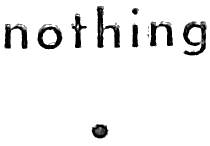Endre Tót
Editions
Year 1971
.
.
-
nothing
Budapest, auto-édition (samizdat), 1971.In-folio, 4 pages, papier carton: sérigraphie 1 couleur (gris clair) ; 297mm x 210 mm.
The number of copies published is unknown (Endre Tót estimates a few dozen copies).
Signed on the back by Endre Tót in blue pen.
-
The layout is vertical. The front cover is titled "nothing" in lowercase letters. Below the title, there is a black dot. On the reverse side of the first and second panels, along their outer margins, there are two screen-printed text bands (50 mm wide and 297 mm long), where the word "nothing" is repeated from top to bottom.
The text on the fourth page is printed horizontally. It reads:
"Budapest, May, 1971", and further down, "Endre Tót . Born in 1937. Sümeg, Hungary"*.Formally, this black dot resembles the one under the title; it could indicate the author’s name. A similar use of signs as a reference to a word or a name can be found in the book Semmi Sem Semmi: Endre Tót uses the cross (x) three times to replace the word "born".
*"Fundamentally, two things: Endre has always been very prolific, and there are certainly dozens of these ‘printed works’ still lying around somewhere. The print run figures may be very different from those indicated.
Endre might recall that ‘private editions’ or ‘personal editions’ during the communist era (which, to be clear, was a dictatorship) were, in fact, samizdat publications, whether or not they carried a political message. This means that the author certainly remembers well the illegal methods through which he produced—or, in Endre’s case, had others produce—printed works.
(If I remember correctly, he had a printer friend who made some of these works for him in black at the printing house...)"*
PETER FARKAS, 21.05.2023 (EMAIL)


